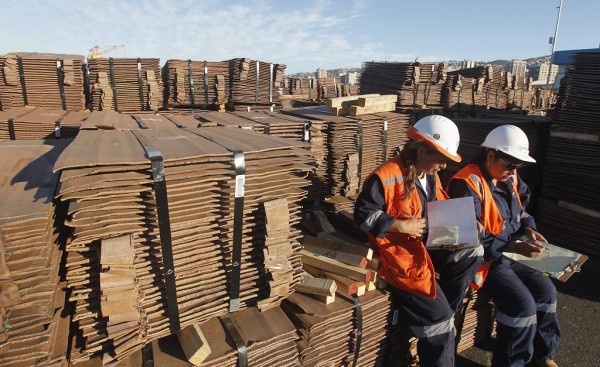Is Copper Mining in Chile on the Decline?
| Eana Maniebo | | Apr 30, 2015 04:19 AM EDT |
(Photo : REUTERS) Port workers check a copper shipment that is to be exported to Asia, in Valparaiso port, northwest of Santiago, Chile.
Copper is considered as the Chilean economy's "lifeblood," as 30 percent of the world's overall copper supply comes from the South American nation. But it seems like the country's revenues are under pressure as high labor costs and lukewarm copper demand are threatening Chile's position as the largest copper producer in the world.
Like Us on Facebook
From 1990 to 2004, copper production grew 9.2 percent annually, while productivity almost doubled as well. But while Chile was responsible for nearly all of the global growth in copper demand between 2005 and 2010, global price of copper has fallen by 40 percent since 2011. Similarly, the average investment of major mining companies in Chile was more than $8 billion in 2012, but only amounted up to $6 million in 2014.
According to Diego Hernandez, chief executive of Antofagasta PLC, there has barely been any growth in the production of copper since 2004. The government has also failed to curb the rising labor costs of late. "Fifteen years ago, Chile still had a competitive advantage in terms of labor as a component of our cash costs," said Hernandez.
"Today, we have similar salaries but we kept the same productivity we had before. Now we have a competitive disadvantage," he added.
The loss of productivity is a result of a decline in ore grade and growth in the workforce. A shortage of qualified labor and strong unions has also driven an increase in salaries.
But this is not the first time that Chile is experiencing a boom and bust in the mining industry. Before World War I, more than 60 percent of Chile's national income came from nitrate. However, the discovery of German chemist Fritz Haber on how to make nitrate from air back in 1909 marked the end of the industry. With this experience, many countries are wondering if Chile learned its lesson: mining diversification.
Only a few mining companies in Chile have dared to get out of the copper bandwagon and mine for minerals with better profit potential. One of them is White Mountain Titanium Corporation (OTCQB: WMTM), the proprietor of the Cerro Blanco Project located in the Atacama Desert in northern Chile. The project's main product is titanium dioxide concentrate in the form of natural rutile. With an estimated 112 million tons rutile resource, the Cerro Blanco Project is expected to become one of the largest primary rutile mines in the world once production starts in 2017. Rutile is essential in the paint and pigment sector, which is currently valued at around $20 billion.
According to Hernandez, the Chile's copper mining industry needs to make fuller use of automation and increase training of young professional miners in order to get back into the game. The Chilean government is already taking steps to train its miners through a potential partnership with Pennsylvania State University.
"We need to work hard first to improve the quality of our people; secondly, we need to look and change our working practices," he said.
TagsChile copper, Chile mining industry, Copper in Chile decline, Antofagasta, White Mountain Titanium
©2015 Chinatopix All rights reserved. Do not reproduce without permission
EDITOR'S PICKS
-

Did the Trump administration just announce plans for a trade war with ‘hostile’ China and Russia?
-

US Senate passes Taiwan travel bill slammed by China
-

As Yan Sihong’s family grieves, here are other Chinese students who went missing abroad. Some have never been found
-

Beijing blasts Western critics who ‘smear China’ with the term sharp power
-

China Envoy Seeks to Defuse Tensions With U.S. as a Trade War Brews
-

Singapore's Deputy PM Provides Bitcoin Vote of Confidence Amid China's Blanket Bans
-

China warns investors over risks in overseas virtual currency trading
-

Chinese government most trustworthy: survey
-

Kashima Antlers On Course For Back-To-Back Titles
MOST POPULAR
LATEST NEWS
Zhou Yongkang: China's Former Security Chief Sentenced to Life in Prison

China's former Chief of the Ministry of Public Security, Zhou Yongkang, has been given a life sentence after he was found guilty of abusing his office, bribery and deliberately ... Full Article
TRENDING STORY

China Pork Prices Expected to Stabilize As The Supplies Recover

Elephone P9000 Smartphone is now on Sale on Amazon India

There's a Big Chance Cliffhangers Won't Still Be Resolved When Grey's Anatomy Season 13 Returns

Supreme Court Ruled on Samsung vs Apple Dispute for Patent Infringement

Microsoft Surface Pro 5 Rumors and Release Date: What is the Latest?











